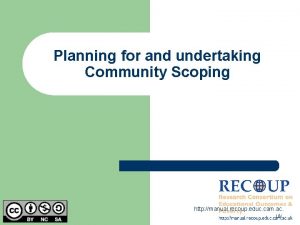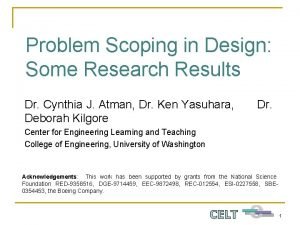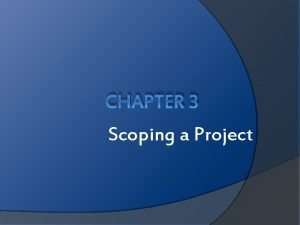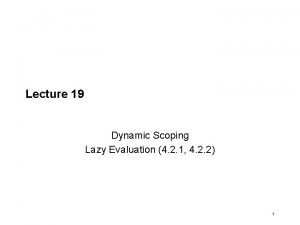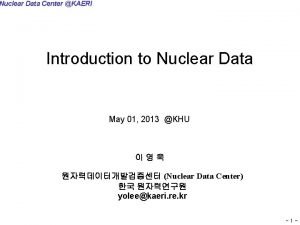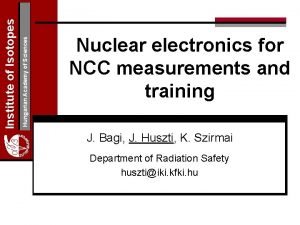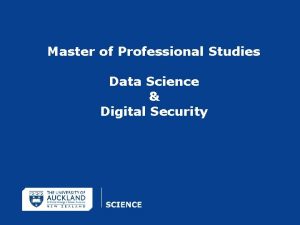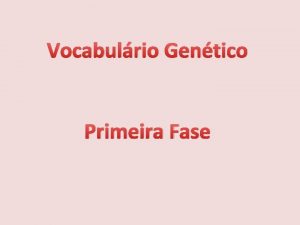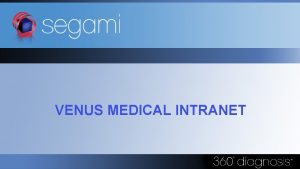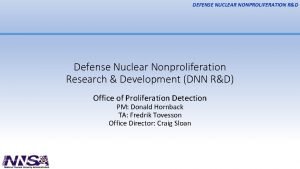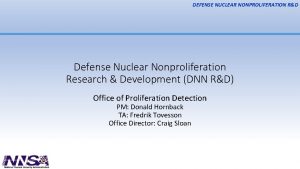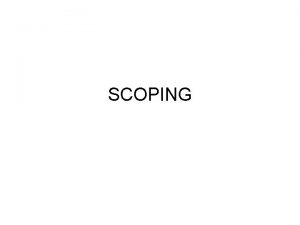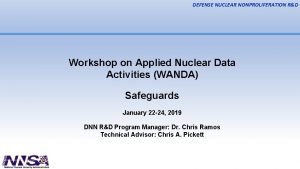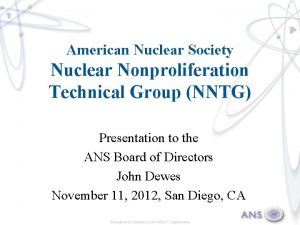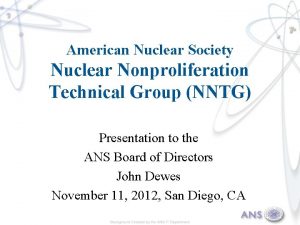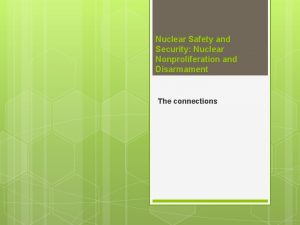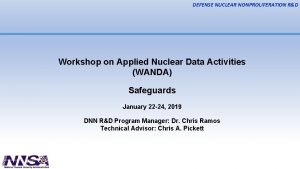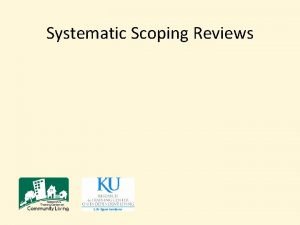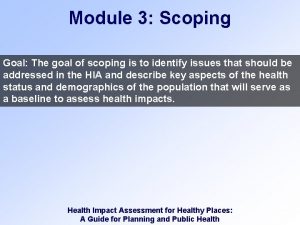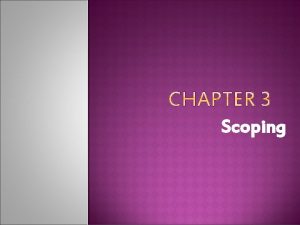NDIAWG Nonproliferation Scoping Studies a n Nuclear Data














- Slides: 14

NDIAWG - Nonproliferation Scoping Studies (a, n) Nuclear Data Scoping Study Catherine Romano David Brown (BNL) Andrea Favalli (LANL) Marco Pigni (ORNL) Michael S. Smith (ORNL) Michael Zerkle (NNL) WANDA 2021 January 25 – February 3, 2021 Stephen Croft (ORNL) Les Nakae (LLNL) Steve Skutnik (ORNL) Will Wieselquist (ORNL)

Project Goal is to provide an ACTIONABLE plan to resolve nuclear data issues that impact applications • Determine the state of the libraries and modeling capabilities • JENDL, TENDL, ENDF • SOURCES 4 C, GEANT, MCNP • Determine application needs • UF 6 enrichment • Spent fuel safeguards • Passive NDA measurements – neutron/gamma • Neutron source characterization – Pu. Be, Am. Be, etc… • Natural neutron background calculations • Targeted alpha therapy – 225 Ac and 227 Th • Isotope Production – high energy alpha beams not part of study • Create a set of recommended tasks to resolve priority nuclear data and simulation needs. ORNL Report to be published shortly

State of the (a, n) Data and Codes • ENDF library is mostly theoretical (TENDL) or based on JENDL (Japanese library) • GNDS format is required to accommodate enhanced data • Many cross sections for priority isotopes have large uncertainties and are based on old data • Neutron energy spectra have large uncertainties • Require more information from experiments to improve evaluation of spectrum • Neutron angular distributions not well known • Impact differential nuclear data measurements using beams • Gamma emission energies • Provide information on excitation states populated for improved neutron emission spectra calculations • May be useful for NDA measurements • Stopping powers not well understood • Application specific measurements are required • Evaluation methods require code modifications • Experiments that capture the population of excited states using gamma measurement data needed to allow theoretical models to correctly predict the neutron spectrum • SOURCES 4 C is unsupported and outdated

Neutron Spectrum is not well known even if the cross section has relatively low uncertainty Calculations of neutron spectrum using MC 21 with the JENDL O(a, n) library and the Naval Nuclear Laboratory (a, n) library compared to experimental data (left) and theoretical calculations of the neutron spectrum from O(a, n) reaction compared to the JENDLE library, SOURCES 4 C, and experimental data (right) [Pigni, 2016].

Uncertainty study of UF 6 cylinders at LANL Goal: to determine the nuclear data contribution to the uncertainty budget for UF 6 cylinder measurements Passive Neutron Enrichment Meter (PNEM) • Two briefcase size polyethylene pods with twelve 3 He tubes at 10 atm. • Varied enrichments and fraction of UF 6 bound to walls • (a, n) source terms built on the Jacobs & Liskien data (‘ 83 and ‘ 85), modeled with SOURCES 4 C • Included a revaluation of the stopping power. Conclusion: The total neutron yield has biggest impact • These detectors are relatively insensitive to neutron energy Neutrons per g 234 U (1σ range) 460 576 ± 7. 3% (533 -618) 474 ± 4. 4% (453 -494) 503 ± ~4% (483 -523) D. P. Broughton, S. Croft, C. Romano, A. Favalli, Sensitivity of the simulations of passive neutron emission from UF 6 cylinder to the uncertainties in both 19 F(α, n) energy spectrum and thick target yield of 234 U in UF 6 (To be submitted to NIM A) 507 ± 1. 1% (501 -513) 610 604 Source (Reilly et al. 1971) (Sampson 1974) (Miller et al. 2014) (Kulisek et al. 2017; uncertainty estimated by Croft et al. 2020) (Croft et al. 2020) SOURCES-4 C (Wilson et al. 2002) Modified SOURCES-4 C (Wilson et al.

Priority Recommendations Prioritized by cross-cutting impact and program specific need for improved fluorine data • • SOURCES 4 C code modernization Evaluation of fluorine, oxygen and carbon (a, n) data Fluorine thick target integral and activation experiments ENDF database modernization and processing code updates

Modernization of the SOURCES 4 C Code PRIORITY TASKS Open-source distribution with software management – requires ownership/maintenance Nuclear data read from ENDF/B o Pointwise in energy (α, n) cross sections. o Prompt neutron emission spectra. o Prompt gamma emission spectra. Enable user input to supply specialized nuclear data file, stopping powers The code will output include reaction rates, neutron and gamma energies A Fortran/C++/Python API allows interface with other codes - MCNP or SCALE/ORIGEN FOLLOW ON TASKS Verification and Validation o Application specific test suites

Evaluation of Current Data • Fluorine Evaluation • An evaluation of Fluorine in year one will provide useful evaluated data to the users until improved benchmark data can be provided. • Improved data requested by IAEA, recent measurement data (Peters 2016) never evaluated • Updated evaluation based on new data once experiments are complete. • Oxygen Evaluation • New, higher resolution data sets will be available from Notre Dame with information on excitation states that will reduce uncertainties at lower energies in the previous evaluations. • Carbon Evaluation • Carbon is the isotope used to calibrate detector systems for all other (a, n) measurements. There are large discrepancies in the data that are currently being examined by multiple groups. An evaluation of the data is needed once the discrepancies are resolved. • Code Development • Reduced R-matrix formalism and penetrability factors to describe the break-up reaction channel and account for both gamma and neutron emission. Postdoc or early career mentoring recommended

Experiments on Fluorine to Reduce Uncertainties PRIORITY TASKS • Fluorine Flat-response 4 p Moderated Neutron Counter Measurements • Measure total yield of neutrons from 19 F(α, n)22 Na per incident alpha particle, integrated over all angles and all alpha energies. • Measure a series of fluorinated compounds to define the role that the stopping power plays in the total yield is important. • Fluorine Activation Measurements • Measure 22 Na decay produced by the 19 F(a, n)22 Na reaction in a thick fluorinated target after bombardment by alpha particles. • Fluorine Neutron Spectrum Measurements • Measure the energy spectrum and angular dependence of neutrons emitted from the thick stopping fluorinated sample simultaneously with the activation measurement • Use time-of-flight combined with deuterated liquid scintillator detector spectrum unfolding. SECONDARY TASK • Thin Fluorine Target Energy-Differential Excitation Function Measurements • 10 ke. V energy steps including neutron and gamma spectrum benchmarked to integral measurements.

ENDF (a, n) Nuclear Data Sub-Library in GNDS Format PRIMARY GOAL: Expanded ENDF (a, n) library • Extend the GNDS tools and format to allow for charged particle reactions • Develop APIs, processing and evaluation codes Fudge, GIDI and AMPX managed by the NEA GNDS Expert Group (EG-GNDS) • Extend FUDGE processing code and the open source GIDI API. • Used by LLNL codes and, in the future, GEANT 4 • Extend the SAMMY evaluation tool and AMPX processing code. • Used by SCALE/ORIGEN

Top Priority isotopes for Nonproliferation Isotope 13 C 17 O 18 O Current State of Data Recent data (4 -6. 5 Me. V) to be published, No evaluation NNL and ORNL evaluation available for next ENDF release - still discrepancies in neutron spectrum Reaction Threshold 450 -800 ke. V Applications NDA/ER, safeguards, advanced reactors, background simulations, alpha therapy Recommendation Low energy measurement needed < 1 Me. V - 4 Me. V. Recent Notre Dame measurement from 4 -6. 5 Me. V. Discrepancies in past data are being examined and new evaluation once data issues resolved. 800 ke. V-1. 2 Me. V safeguards, reactors, NDA/ER, Background simulations, alpha therapy Recent Notre Dame measurement from 0. 8 - 7 Me. V will provide data to resolve discrepancies in neutron spectrum. Updated evaluation needed 850 ke. V-1. 4 Me. V safeguards, reactors, NDA/ER, Background simulations, alpha therapy Recent Notre Dame measurement from 2 -8 Me. V will provide data to resolve discrepancies in neutron spectrum. Updated evaluation needed Previous cross section measurements provided improvement. Still need total neutron, neutron spectrum, gamma emission with lower uncertainty per IAEA. A combination of improved total cross section, angular distributions, neutron energy spectra, activation, and thick safeguards UF 6, FLi. Be reactors, fuel cycle & waste

Secondary Priority – Safeguards and Reactors 7 Li 9 Be 11 B 10 B 27 Al Adjusted evaluation based on JENDL data available for next ENDF release, large discrepancies in data require new experiments 3 -4 Me. V NNL evaluation available for next ENDF release 200 Ke. V No evaluation Recent Experiments up to 4. 5 Me. V, requires evaluation Discrepancies in data from 1970 s No evaluation 600 ke. V 1 Me. V 3 Me. V FLIBe reactors, NDA/ER, spent fuel safeguards, Actinide-Li neutron sources FLIBe reactors, NDA/ER, spent fuel safeguards, Actinide-Be neutron sources New experiments with ability to resolve excitation states and reaction channels and new evaluations are needed in order to accurately model neutron sources. Neutron spectrum been validated by NNL by adjusting JENDL for additional breakup reaction channels. Would benefit from new measurements that provide information on reaction channels Reactors, safeguards Only measured up to 2. 5 Me. V Reactors, safeguards NDA/ER, advanced reactor fuel and spent fuel safeguards Recent experiments from 1. 5 -4. 5 Me. V conducted at Notre Dame. Data above 4. 5 Me. V and an evaluation are needed New experiments and evaluations with resolved excitation states and neutron spectrum are needed for advanced reactor fuels and emergency response.

Lower priority 23 Na 25 Mg Need new experiments and evaluation 26 Mg Need new experiments and evaluation 29 Si Need new experiments and evaluation 30 Si Need new experiments and evaluation 37 Cl Need new experiments and evaluation 41 K Need new experiments and evaluation molten salt reactors New experiments with ability to resolve excitation states and evaluations are needed for advanced reactor fuels Mg. Cl molten salt, fuel cladding, astrophysics Recent Notre Dame measurement from 1. 5 -3. 5 Me. V. Experiments up to 6. 5 Me. V needed for advanced reactors. Evaluation needed Mg. Cl molten salt, fuel cladding, astrophysics Planned Notre Dame measurement from 1. 5 -3. 5 Me. V. Experiments up to 6. 5 Me. V needed for advanced reactors. Evaluation needed Advanced reactor fuels New experiments with ability to resolve excitation states and evaluations are needed for advanced reactor fuels 4 Me. V Advanced reactor fuels New experiments with ability to resolve excitation states and evaluations are needed for advanced reactor fuels 1 Me. V Chloride-based (Na, Li. Cl, Mg. Cl) molten salt fuel, pyroprocessing New experiments with ability to resolve excitation states and evaluations are needed for advanced reactor fuels 3. 5 Me. V Pyroprocessing, molten salt fuel (FLi. Na. K) New experiments with ability to resolve excitation states and evaluations are needed for advanced reactor fuels 3. 5 Me. V 3 Me. V 2 Me. V

Thank You! • This work sponsored by the U. S. Department of Energy (DOE), Office of Defense Nuclear Nonproliferation’s Nonproliferation Research and Development (NA-22). • Funded through the NDIAWG FOA
 How do you undertake community scoping
How do you undertake community scoping What is problem scoping?
What is problem scoping? Project scoping exercise
Project scoping exercise Project scoping
Project scoping Dynamic scoping
Dynamic scoping Lesson 15 nuclear quest nuclear reactions
Lesson 15 nuclear quest nuclear reactions Fisión nuclear vs fision nuclear
Fisión nuclear vs fision nuclear Paradigm shift from women studies to gender studies
Paradigm shift from women studies to gender studies N233pa
N233pa Nuclear data acquisition
Nuclear data acquisition Compsci 762
Compsci 762 Presentation of business information
Presentation of business information Nucleoplasm
Nucleoplasm Intranetvenus
Intranetvenus Fission and fusion similarities
Fission and fusion similarities
